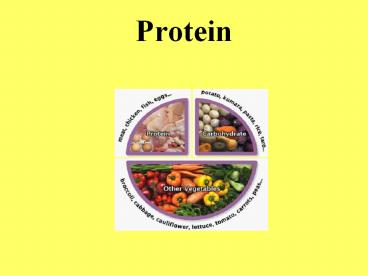Protein - PowerPoint PPT Presentation
1 / 22
Title:
Protein
Description:
1 cup Muesli 15 1 meat pie 13. 1 cup porridge 4 1 cup hot chips 9.5 ... 100 g cottage cheese 15 100 g chicken breast 25. 1 cup ice cream 6 100 g lamb 26 ... – PowerPoint PPT presentation
Number of Views:116
Avg rating:3.0/5.0
Title: Protein
1
Protein
2
Nitrogen Cycle
- Plants use N2 to make a.as and proteins
- Animals eat plants
- Humans consume plants and animals
- Decomposed organic matter puts N2 back into soil
to be use by plants
3
Protein
- Structure
- Building block of all proteins is the amino acid
- Contains carbon, hydrogen, oxygen, nitrogen
- Polypeptides made of 100-300 aas
- Eg leucine, alanine, serine etc
4
Protein synthesis
- Amino acids join with a peptide bond
- Peptide bond formed between
- Carboxyl OH group of 1st amino acid
- Nitrogen group of 2nd amino acid
- Polypeptide
- Protein unit that contains many peptide bonds
5
Amino acids
- 9 essential amino acids
- 11 non-essential a.a.
- Long chains of amino acids make up different
proteins - Potential for endless combinations of amino acids
6
Non-essential a.a.
- Can be made in the body from essential a.a. or
from other non-essential amino acids or be
supplied by body proteins - Most foods except fruit, vegetables and fats
contain protein - Non-animal products are a significant source of
protein
7
Essential amino acids
- The body cannot synthesise these from other amino
acids - Must be provided in the diet or own body proteins
will be used - Meat, poultry, fish, eggs, dairy products and
soya beans
8
Functions of PROTEIN
- Growth, maintenance and repair of all body cells
- Replacement
- Fluid balance
- Acid base balance
- antibodies
- Hormones
- Transport proteins
- enzymes
- Source of energy
9
Examples of body proteins
- Collagen and elastin skin
- Keratin hair
- Albumin blood
- Hemoglobin red blood cells
- Insulin hormone
- Lipase, protease enzymes
- DNA and RNA genetic material
10
Digestion, absorption and use
- Peptide chain straightened to allow access for
enzymes - Broken down to single a.a.
- Transported via blood to cells
- Held in a.a. pool for up to eight hours
- Converted to fat unless used for cell repair or
energy
11
Protein Quality
- Animal protein
- Wine, vinegar, salt, acid, heat denatures
proteins, loosening bonds making it more tender - Denaturing proteins makes them more available to
digestive enzymes for absorption - Vegetable Protein
- Less well digested
- Encased cell walls thus need to be cooked
- Contain enzymes that interfere with protein
digestion
12
Reference Protein
- Eggs
- Most complete and digestible protein
- Used as a standard for measuring protein quality
- Protein Quality
- BV (Biological Value)
- BV amount of protein nitrogen that is retained
for growth and maintenance
13
Health effects of protein
- Protein Deficiency
- Poor growth in children
- Weight loss and wasting in adults
- Two conditions
- Marasmus
- Kwashiorkor
14
Risks with high protein intake
- Excess energy intake
- May limit CHO intake
- Increased need for water
- Calcium losses
- ? Stress on the kidneys
15
RDI and Intakes
- RDIs
- Men 19-64 yrs
- 55g/day
- Women 19-54 yrs
- 45g/day
- Protein intake in NZ
- 15 yrs plus
- 105g/day
- 15 of energy
- 15yrs plus
- 71g/day
- 16 of energy
16
Estimating protein needs
- To maintain protein balance in the body, the best
estimate of protein required for nearly all
adults is 0.8g/kg body weight - When might the body be in positive balance ?
- When might the body be in negative balance ?
17
Food sources of protein
- Animal meats (beef, chicken, fish etc), eggs,
milk and milk products - Vegetable legumes (dried beans, peas and
lentils), nuts, seeds, grains eg rice, corn etc - NZ Diet -beef and veal 14, bread 11, milk 10,
poultry 7, seafood 7.
18
Vegetarian diets
- Vegetarian diets with no animal products can
supply all the essential amino acids - Most vegetable proteins are only short of one
a.a. the limiting a.a. - The limiting a.a. can be supplied by another
vegetable protein - Knowledge of food combinations important
19
Example
- Wheat is low in lysine but served with dried
beans, rich in lysine (limiting in methionine)
can provide the correct balance of all essential
aas.
20
Protein content of food
- 1 Bagel 6 grams 4 fish fingers 9
- 1 cup Muesli 15 1 meat pie 13
- 1 cup porridge 4 1 cup hot chips 9.5
- 1 cup Soya milk 8 1 sausage roll 10
- 1 cup pasta 4.5 100 g gurnard 26.5
- 1 cup brown rice 5.5 100 g tuna 23
- 100 g cheese 25 100 g fillet steak 27
- 100 g cottage cheese 15 100 g chicken breast 25
- 1 cup ice cream 6 100 g lamb 26
- 1 cup milk 8.5-11 100 g turkey breast 29
- 1 pot yoghurt 7 100 g luncheon 11
- 1 hamburger 15 100 g mussels 23
- 1 Big Mac 27 100 g peanut butter 29
- 1 cup coleslaw 4 1 Mars bar 3.2
- 100 g cauliflower 2 1 cup lentils 10
21
Practical advice
- Protein should be provided by wide range of
available foods, including lean meat, chicken and
seafood, eggs and milk. Bread is also important
source. Include some vegetable sources too. - Choose low fat options of meat and milk products.
- If vegetarian, choose protein from diverse plant
sources (legumes, nuts, breads, cereals etc.) If
lacto-ovo vegetarian, include eggs and milk
products.
22
(No Transcript)































